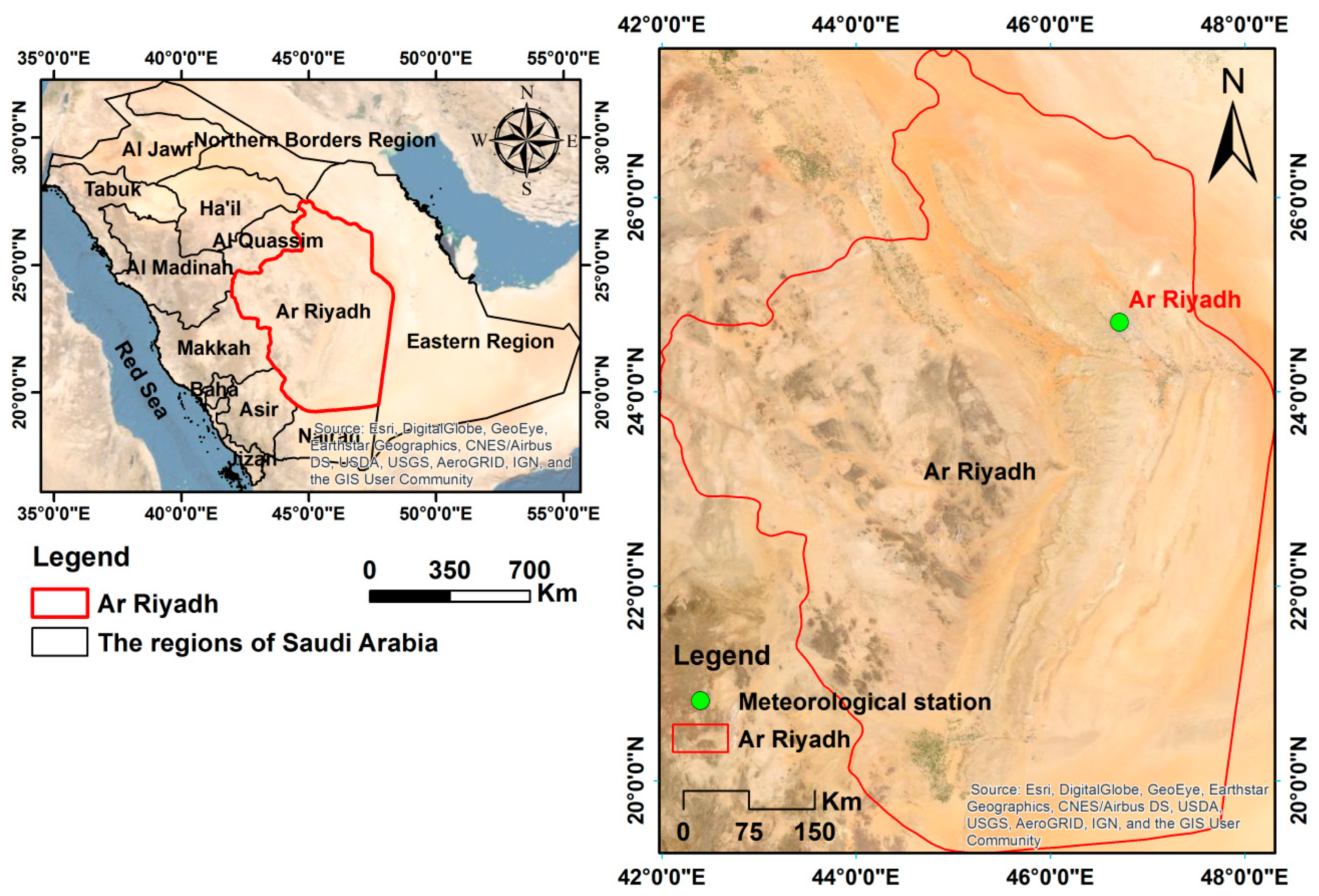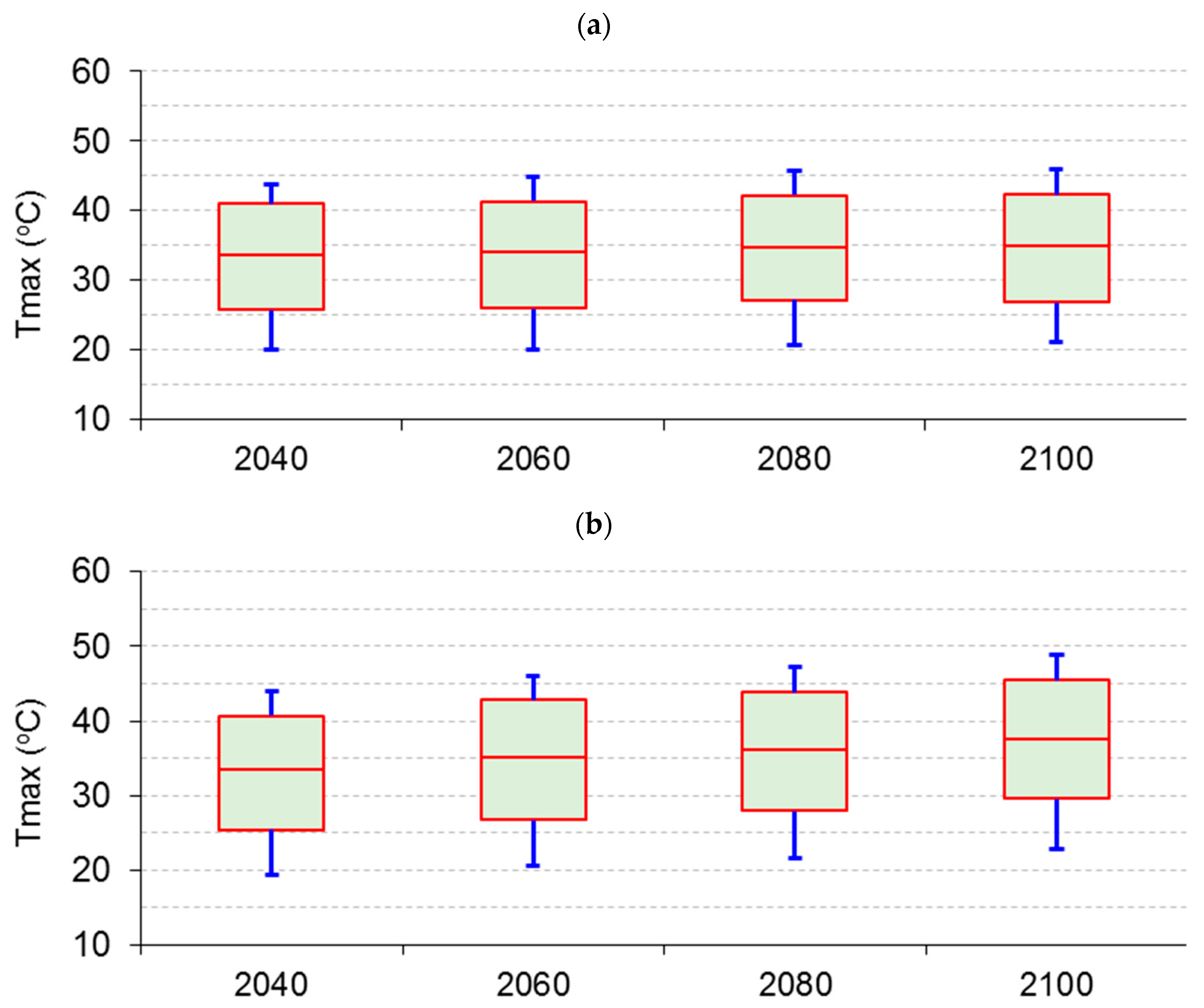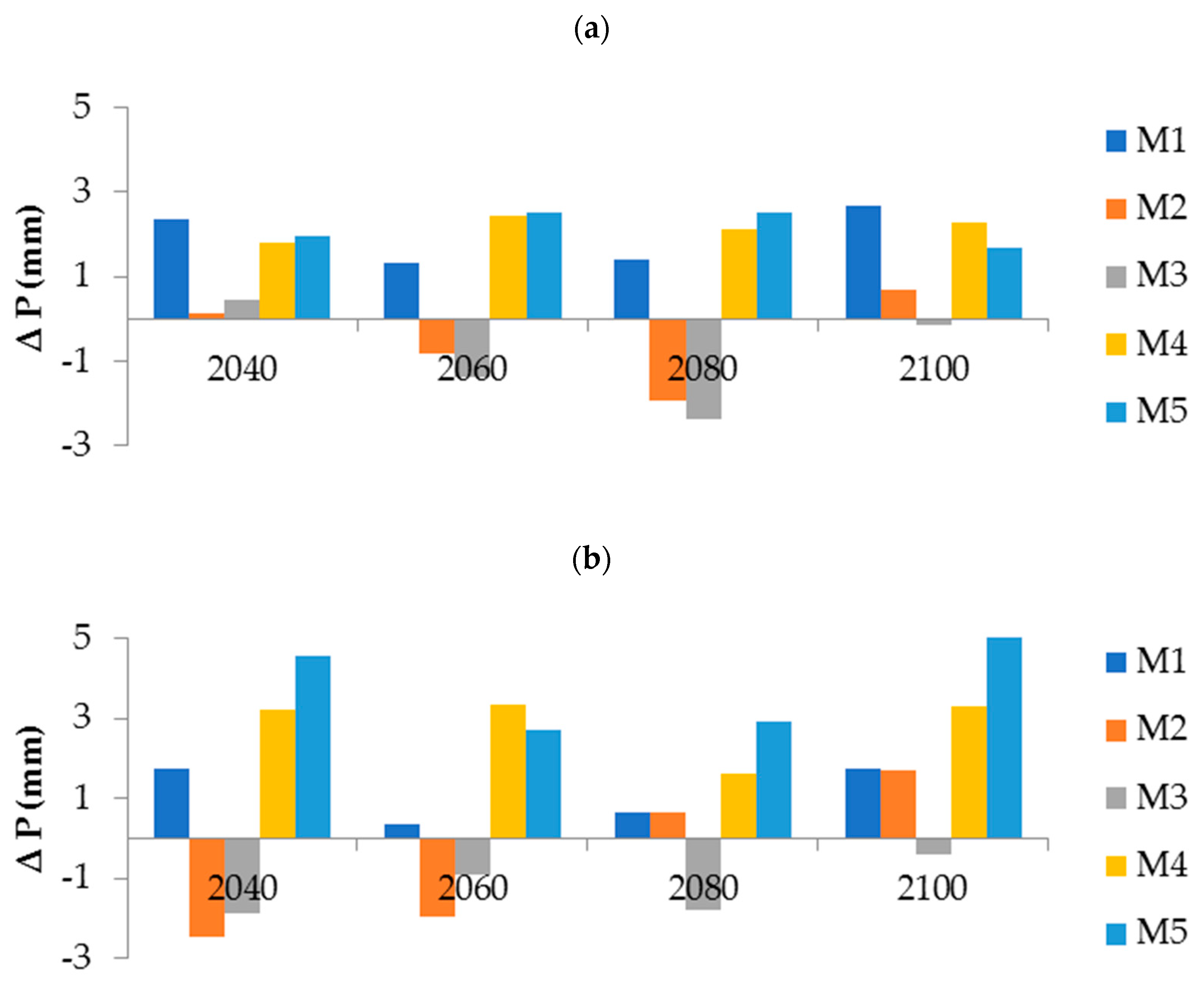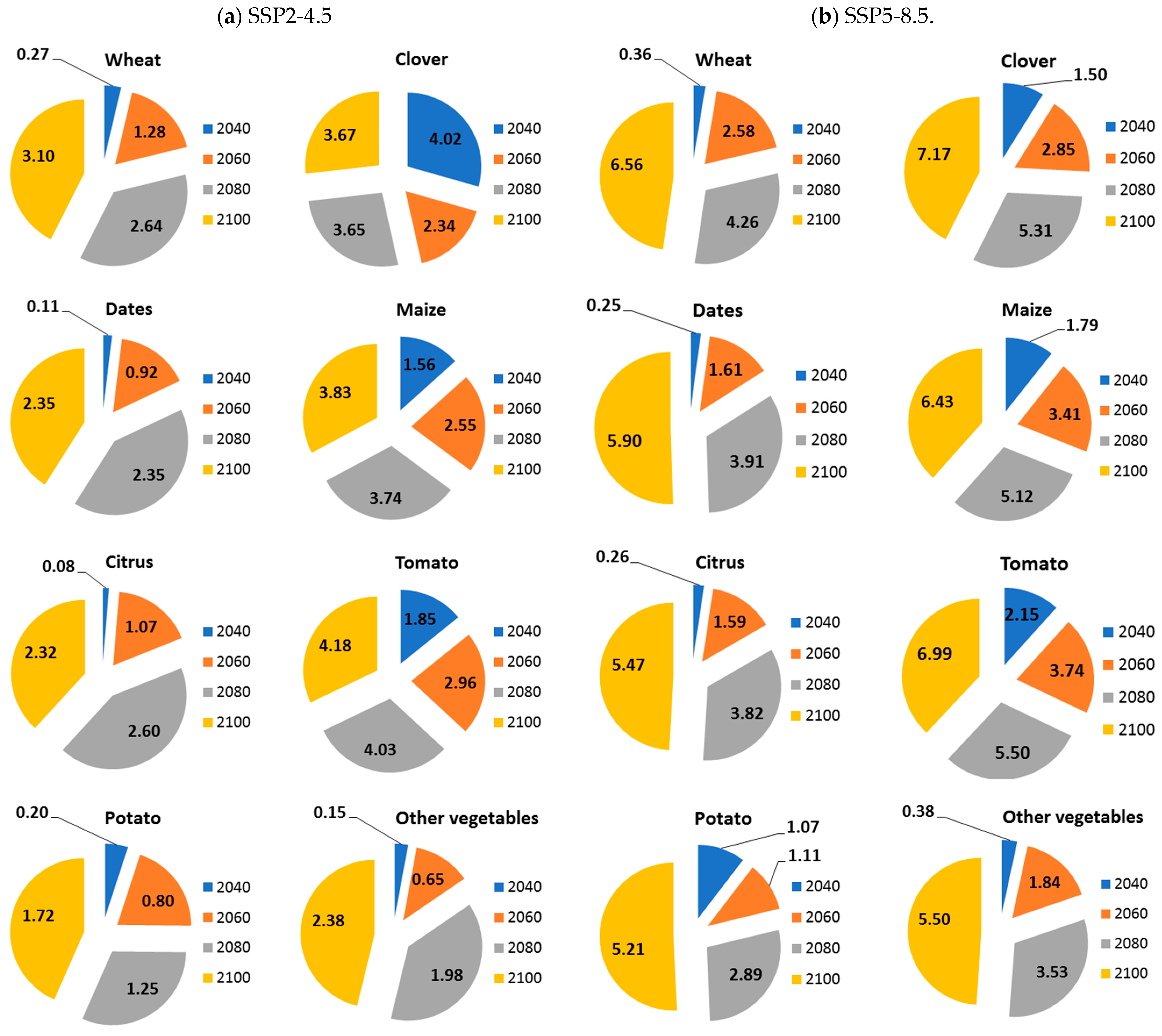Potential Effects of Climate Change on Agricultural Water Resources in Riyadh Region, Saudi Arabia
Abstract
1. Introduction
2. Materials and Methods
2.1. Study Area Description
2.2. Climate Data
2.3. CROPWAT 8 Model Description
3. Results
3.1. Temperature and Rainfall Changes
3.2. Reference Evapotranspiration (ETo) Variation
3.3. Crop Water Requirement
4. Discussion
4.1. Maximum Temperature Changes
4.2. Minimum Temperature Changes
4.3. Rainfall Changes
4.4. ETo Variation
4.5. ETc Variation
4.6. Deficit in Crop Areas (%) Due to the Climate Change Scenarios
5. Conclusions
Author Contributions
Funding
Institutional Review Board Statement
Informed Consent Statement
Data Availability Statement
Acknowledgments
Conflicts of Interest
References
- Chowdhury, S.; Al-Zahrani, M.; Abbas, A. Implications of climate change on crop water requirements in arid region: An example of Al-Jouf, Saudi Arabia. J. King Saud Univ. Eng. Sci. 2016, 28, 21–31. [Google Scholar] [CrossRef]
- Tarawneh, Q.Y.; Chowdhury, S. Trends of Climate Change in Saudi Arabia: Implications on Water Resources. Climate 2018, 6, 8. [Google Scholar] [CrossRef]
- Mostafa, S.M.; Wahed, O.; El-Nashar, W.Y.; El-Marsafawy, S.M.; Abd-Elhamid, H.F. Impact of climate change on water resources and crop yield in the Middle Egypt region. J. Water Supply Res. Technol. 2021, 70, 1066–1084. [Google Scholar] [CrossRef]
- Schwartz, J. How Much, Exactly, Will Greenhouse Gases Heat the Planet? Available online: https://www.nytimes.com/2020/07/22/climate/global-warming-temperaturerange.html (accessed on 15 March 2022).
- Iglesias, A.; Garrote, L. Adaptation strategies for agricultural water management under climate change in Europe. Agric. Water Manag. 2015, 155, 113–124. [Google Scholar] [CrossRef]
- Ritchie, H.; Roser, M. CO₂ and Greenhouse Gas Emissions—Our World in Data. Available online: https://ourworldindata.org/co2-and-other-greenhouse-gas-emissions (accessed on 18 December 2021).
- Kaini, S.; Gardner, T.; Sharma, A.K. Assessment of socio-economic factors impacting on the cropping intensity of an irrigation scheme in developing countries. Irrig. Drain. 2020, 69, 363–375. [Google Scholar] [CrossRef]
- Schilling, J.; Hertig, E.; Tramblay, Y.; Scheffran, J. Climate change vulnerability, water resources and social implications in North Africa. Reg. Environ. Chang. 2020, 20, 15. [Google Scholar] [CrossRef]
- Almazroui, M.; Halwani, H.A.; Islam, N.; Ghulam, A.B.S.; Hantoush, A.S. Regional and seasonal variation of climate extremes over Saudi Arabia: Observed evidence for the period 1978–2021. Arab. J. Geosci. 2022, 15, 1605. [Google Scholar] [CrossRef]
- Haque, M.I.; Khan, M.R. Impact of climate change on food security in Saudi Arabia: A roadmap to agriculture-water sustainability. J. Agribus. Dev. Emerg. Econ. 2022, 12, 1–18. [Google Scholar] [CrossRef]
- Chowdhury, S.; Al-Zahrani, M. Implications of Climate Change on Water Resources in Saudi Arabia. Arab. J. Sci. Eng. 2013, 38, 1959–1971. [Google Scholar] [CrossRef]
- Al-Zawad, F.M. Impacts of climate change on water resources in Saudi Arabia. In Proceedings of the 3rd International Conference on Water Resources and Arid Environments and the 1st ArabWater Forum, Ar Riyad, Saudi Arabia, 16–19 November 2008. [Google Scholar]
- Rehman, S.; Al-Hadhrami, L.M. Extreme Temperature Trends on the West Coast of Saudi Arabia. Atmos. Clim. Sci. 2012, 2, 351–361. [Google Scholar] [CrossRef]
- Almazroui, M. Simulation of present and future climate of Saudi Arabia using a regional climate model (PRECIS). Int. J. Clim. 2013, 33, 2247–2259. [Google Scholar] [CrossRef]
- Sasaki, Y. The Truth of the F-Measure. 2007. Available online: https://www.fao.org/land-water/databases-and-software/cropwat/en/ (accessed on 10 February 2022).
- Alotaibi, M.; Alhajeri, N.S.; Al-Fadhli, F.M.; Al Jabri, S.; Gabr, M. Impact of Climate Change on Crop Irrigation Requirements in Arid Regions. Water Resour. Manag. 2023, 37, 1965–1984. [Google Scholar] [CrossRef]
- Gabr, M.E. Land reclamation projects in the Egyptian Western Desert: Management of 1.5 million acres of groundwater irrigation. Water Int. 2023, 48, 240–258. [Google Scholar] [CrossRef]
- Hordofa, A.T.; Leta, O.T.; Alamirew, T.; Chukalla, A.D. Response of Winter Wheat Production to Climate Change in Ziway Lake Basin. Sustainability 2022, 14, 13666. [Google Scholar] [CrossRef]
- Makar, R.S.; Shahin, S.A.; El-Nazer, M.; Wheida, A.; El-Hady, M.A. Evaluating the Impacts of Climate Change on Irrigation Water Requirements. Sustainability 2022, 14, 14833. [Google Scholar] [CrossRef]
- Feng, X.; Wu, F.; Zai, S.; Wang, D.; Zhang, Y.; Chai, Q. Characteristics and Impacts of Water–Thermal Variation on Grain Yield in the Henan Province, China, on Multiple Time Scales. Agronomy 2023, 13, 429. [Google Scholar] [CrossRef]
- Esteves, R.; Calejo, M.J.; Rolim, J.; Teixeira, J.L.; Cameira, M.R. Framework for Assessing Collective Irrigation Systems Resilience to Climate Change—The Maiorga Case Study. Agronomy 2023, 13, 661. [Google Scholar] [CrossRef]
- Shen, X.; Liu, Y.; Zhang, J.; Wang, Y.; Ma, R.; Liu, B.; Lu, X.; Jiang, M. Asymmetric Impacts of Diurnal Warming on Vegetation Carbon Sequestration of Marshes in the Qinghai Tibet Plateau. Glob. Biogeochem. Cycles 2022, 36, e2022GB007396. [Google Scholar] [CrossRef]
- Yin, J.; Slater, L.; Gu, L.; Liao, Z.; Guo, S.; Gentine, P. Global Increases in Lethal Compound Heat Stress: Hydrological Drought Hazards Under Climate Change. Geophys. Res. Lett. 2022, 49, e2022GL100880. [Google Scholar] [CrossRef]
- Gabr, M.E. Modelling net irrigation water requirements using FAO-CROPWAT 8.0 and CLIMWAT 2.0: A case study of Tina Plain and East South ElKantara regions, North Sinai, Egypt. Arch. Agron. Soil Sci. 2021, 68, 1322–1337. [Google Scholar] [CrossRef]
- MOEP (The Ministry of Economy and Planning). The Ninth Development Plan (2010–2014); Legal Deposit No. 16/0694; MOEP (The Ministry of Economy and Planning): Riyadh, Saudi Arabia, 2010; ISSN 1319-4836.
- Al-Mutaz, I.S. Water resources development in Riyadh, Saudi Arabia. Desalination 1987, 64, 193–202. [Google Scholar] [CrossRef]
- Rong, X.Y.; Li, J.; Chen, H.M.; Xin, Y.F.; Su, J.Z.; Hua, L.J.; Zhang, Z.Q. Introduction of CAMS-CSM model and its participation in CMIP6. Clim. Chang. Res. 2019, 15, 540–544. (In Chinese) [Google Scholar] [CrossRef]
- Bi, D.; Dix, M.; Marsland, S.; O’Farrell, S.; Rashid, H.; Uotila, P.; Hirst, A.; Kowalczyk, E.; Golebiewski, M.; Sullivan, A.; et al. The ACCESS coupled model: Description, control climate and evaluation. J. South. Hemisph. Earth Syst. Sci. 2013, 63, 41–64. [Google Scholar] [CrossRef]
- Wu, T.; Lu, Y.; Fang, Y.; Xin, X.; Li, L.; Li, W.; Jie, W.; Zhang, J.; Liu, Y.; Zhang, L.; et al. The Beijing Climate Center Climate System Model (BCC-CSM): The main progress from CMIP5 to CMIP6. Geosci. Model Dev. 2019, 12, 1573–1600. [Google Scholar] [CrossRef]
- Voldoire, A.; Saint-Martin, D.; Sénési, S.; Decharme, B.; Alias, A.; Chevallier, M.; Colin, J.; Guérémy, J.; Michou, M.; Moine, M.; et al. Evaluation of CMIP6 DECK Experiments With CNRM-CM6-1. J. Adv. Model. Earth Syst. 2019, 11, 2177–2213. [Google Scholar] [CrossRef]
- Yukimoto, S.; Kawai, H.; Koshiro, T.; Oshima, N.; Yoshida, K.; Urakawa, S.; Tsujino, H.; Deushi, M.; Tanaka, T.; Hosaka, M.; et al. The Meteorological Research Institute Earth System Model Version 2.0, MRI-ESM2.0: Description and Basic Evaluation of the Physical Component. J. Meteorol. Soc. Jpn. Ser. II 2019, 97, 931–965. [Google Scholar] [CrossRef]
- Smith, M. CROPWAT: A Computer Program for Irrigation Planning and Management; FAO Irrigation and Drainage Paper No. 46; FAO: Rome, Italy, 1992; p. 126. [Google Scholar]
- Incoom, A.B.M.; Adjei, K.A.; Odai, S.N.; Akpoti, K.; Siabi, E.K. Impacts of climate change on crop and irrigation water requirement in the Savannah regions of Ghana. J. Water Clim. Chang. 2022, 13, 3338–3356. [Google Scholar] [CrossRef]
- Al-Omran, A.; Eid, S.; Alshammari, F. Crop water requirements of date palm based on actual applied water and Penman–Monteith calculations in Saudi Arabia. Appl. Water Sci. 2019, 9, 69. [Google Scholar] [CrossRef]
- El-Rawy, M.; Batelaan, O.; Al-Arifi, N.; Alotaibi, A.; Abdalla, F.; Gabr, M.E. Climate Change Impacts on Water Resources in Arid and Semi-Arid Regions: A Case Study in Saudi Arabia. Water 2023, 15, 606. [Google Scholar] [CrossRef]
- Brouwer, C.; Prins, K.; Heibloem, M. Irrigation Water Management: Irrigation Scheduling. Training Manual No. 4, 1989. Available online: https://www.fao.org/3/t7202e/t7202e00.htm (accessed on 12 November 2022).
- Almazroui, M.; Islam, M.N.; Saeed, S.; Saeed, F.; Ismail, M. Future Changes in Climate over the Arabian Peninsula based on CMIP6 Multimodel Simulations. Earth Syst. Environ. 2020, 4, 611–630. [Google Scholar] [CrossRef]
- Kaushika, G.; Arora, H.; Ks, H.P. Analysis of climate change effects on crop water availability for paddy, wheat and berseem. Agric. Water Manag. 2019, 225, 105734. [Google Scholar] [CrossRef]
- You, L.; Rosegrant, M.W.; Wood, S.; Sun, D. Impact of growing season temperature on wheat productivity in China. Agric. For. Meteorol. 2009, 149, 1009–1014. [Google Scholar] [CrossRef]
- Gabr, M.E.-S. Management of irrigation requirements using FAO-CROPWAT 8.0 model: A case study of Egypt. Model. Earth Syst. Environ. 2021, 8, 3127–3142. [Google Scholar] [CrossRef]
- Ludwig, F.; Asseng, S. Climate change impacts on wheat production in a Mediterranean environment in Western Australia. Agric. Syst. 2006, 90, 159–179. [Google Scholar] [CrossRef]
- Elnashar, W.; Elyamany, A. Managing Risks of Climate Change on Irrigation Water in Arid Regions. Water Resour. Manag. 2022, 37, 2429–2446. [Google Scholar] [CrossRef]
- Awad, A.; Luo, W.; Al-Ansari, N.; Elbeltagi, A.; El-Rawy, M.; Farres, H.N.; Gabr, M.E.-S. Farmers’ Awareness in the Context of Climate Change: An Underutilized Way for Ensuring Sustainable Farmland Adaptation and Surface Water Quality. Sustainability 2021, 13, 11802. [Google Scholar] [CrossRef]
- Al-Maktoumi, A.; Zekri, S.; El-Rawy, M.; Abdalla, O.; Al-Wardy, M.; Al-Rawas, G.; Charabi, Y. Assessment of the impact of climate change on coastal aquifers in Oman. Arab. J. Geosci. 2018, 11, 501. [Google Scholar] [CrossRef]
- Gabr, M.E.; El Shorbagy, A.M.; Faheem, H.B. Utilizing the Harvesting of Rainwater to Provide Safe Road Transportation Efficiency and Increase Water Resources in the Context of Climatic Change. Sustainability 2022, 14, 9656. [Google Scholar] [CrossRef]
- El-Rawy, M.; Elsadek, W.M.; De Smedt, F. Flood hazard assessment and mitigation using a multi-criteria approach in the Sinai Peninsula, Egypt. Nat. Hazards 2023, 115, 215–236. [Google Scholar] [CrossRef]
- Gabr, M.E.; El-Ghandour, H.A.; Elabd, S.M. Prospective of the utilization of rainfall in coastal regions in the context of climatic changes: Case study of Egypt. Appl. Water Sci. 2023, 13, 19. [Google Scholar] [CrossRef]













| Parameter | Wheat | Clover | Other Vegetables | Dates | Maize | Citrus | Tomato | Potato |
|---|---|---|---|---|---|---|---|---|
| Planting date | 15 January | 1 December | 1 March | 1 April | 1 April | 1 March | 1 April | 15 January |
| Harvest date | 24 May | 30 November | 3 June | 3 August | 3 August | 28 February | 23 August | 24 May |
| Cultivated Area (ha) | 30,896 | 50,090 | 40,879 | 43,178 | 2212 | 3582 | 4383 | 3446 |
| Tmax (°C) | ||||||||||
|---|---|---|---|---|---|---|---|---|---|---|
| SSP2-4.5 | SSP5-8.5 | |||||||||
| Average | Max. | Min. | ΔT | Change (%) | Average | Max. | Min. | ΔT | Change (%) | |
| 2020 | 32.77 | 42.20 | 22.1 | - | - | 32.77 | 42.20 | 22.1 | - | - |
| 2040 | 32.42 | 43.88 | 20.03 | −0.34 | −1.05 | 32.58 | 44.08 | 19.39 | −0.19 | −0.58 |
| 2060 | 33.20 | 44.86 | 20.07 | 0.43 | 1.31 | 34.18 | 46.00 | 20.55 | 1.42 | 4.32 |
| 2080 | 34.10 | 45.85 | 20.68 | 1.33 | 4.06 | 35.27 | 47.26 | 21.48 | 2.50 | 7.63 |
| 2100 | 34.23 | 45.93 | 21.12 | 1.46 | 4.46 | 36.73 | 48.89 | 22.86 | 3.97 | 12.11 |
| Tmin (°C) | ||||||||||
| 2020 | 19.7 | 27.6 | 10.5 | - | - | 19.7 | 27.6 | 10.5 | - | - |
| 2040 | 18.91 | 28.46 | 7.69 | −0.79 | −2.43 | 18.91 | 28.64 | 7.32 | −0.79 | −2.42 |
| 2060 | 19.57 | 29.40 | 7.96 | −0.13 | −0.40 | 20.23 | 29.99 | 8.38 | 0.53 | 1.63 |
| 2080 | 20.19 | 29.98 | 8.37 | 0.49 | 1.49 | 21.74 | 31.87 | 9.82 | 2.04 | 6.23 |
| 2100 | 20.72 | 30.41 | 9.34 | 1.02 | 3.10 | 22.87 | 32.96 | 10.92 | 3.17 | 9.66 |
| Rainfall (mm) | ||||||||||
| 2020 | 6.82 | 22.00 | 0.40 | - | - | 6.82 | 22.00 | 0.40 | - | - |
| 2040 | 8.15 | 14.62 | 2.07 | 1.34 | 4.08 | 7.85 | 13.98 | 1.41 | 1.04 | 3.16 |
| 2060 | 7.63 | 15.96 | 1.73 | 0.81 | 2.48 | 7.51 | 19.87 | 1.10 | 0.69 | 2.11 |
| 2080 | 7.16 | 14.25 | 1.69 | 0.35 | 1.06 | 7.61 | 15.02 | 1.61 | 0.80 | 2.43 |
| 2100 | 8.25 | 16.65 | 1.84 | 1.43 | 4.36 | 9.20 | 15.81 | 1.73 | 2.38 | 7.27 |
| SSP2-4.5 | SSP5-8.5 | |||||||||
|---|---|---|---|---|---|---|---|---|---|---|
| Average | Max. | Min. | ΔT | Change (%) | Average | Max. | Min. | ΔT | Change (%) | |
| 2020 | 3.66 | 5.28 | 1.85 | 3.66 | 5.28 | 1.85 | ||||
| 2040 | 3.64 | 5.42 | 1.76 | −0.02 | −0.66 | 3.64 | 5.43 | 1.77 | −0.02 | −0.48 |
| 2060 | 3.68 | 5.48 | 1.79 | 0.02 | 0.48 | 3.72 | 5.52 | 1.82 | 0.06 | 1.52 |
| 2080 | 3.73 | 5.54 | 1.83 | 0.06 | 1.75 | 3.80 | 5.63 | 1.89 | 0.14 | 3.85 |
| 2100 | 3.74 | 5.55 | 1.84 | 0.08 | 2.18 | 3.89 | 5.74 | 1.96 | 0.23 | 6.35 |
| SSP2-4.5 | SSP5-8.5 | |||||||
|---|---|---|---|---|---|---|---|---|
| NIWR (MCM) | GIWR (MCM) | ΔGIWR | Change (%) | NIWR (MCM) | GIWR (MCM) | ΔGIWR | Change (%) | |
| 2020 | 1315.8 | 1634.9 | - | 1315.8 | 1634.9 | - | - | |
| 2040 | 1334.2 | 1659.7 | 24.7 | 1.5 | 1324.1 | 1645.9 | 11.0 | 0.7 |
| 2060 | 1335.8 | 1660.5 | 25.6 | 1.6 | 1345.3 | 1672.3 | 37.4 | 2.3 |
| 2080 | 1354.0 | 1683.0 | 48.0 | 2.9 | 1375.6 | 1709.9 | 75.0 | 4.6 |
| 2100 | 1355.7 | 1685.2 | 50.3 | 3.1 | 1403.7 | 1744.8 | 109.9 | 6.7 |
Disclaimer/Publisher’s Note: The statements, opinions and data contained in all publications are solely those of the individual author(s) and contributor(s) and not of MDPI and/or the editor(s). MDPI and/or the editor(s) disclaim responsibility for any injury to people or property resulting from any ideas, methods, instructions or products referred to in the content. |
© 2023 by the authors. Licensee MDPI, Basel, Switzerland. This article is an open access article distributed under the terms and conditions of the Creative Commons Attribution (CC BY) license (https://creativecommons.org/licenses/by/4.0/).
Share and Cite
El-Rawy, M.; Fathi, H.; Zijl, W.; Alshehri, F.; Almadani, S.; Zaidi, F.K.; Aldawsri, M.; Gabr, M.E. Potential Effects of Climate Change on Agricultural Water Resources in Riyadh Region, Saudi Arabia. Sustainability 2023, 15, 9513. https://doi.org/10.3390/su15129513
El-Rawy M, Fathi H, Zijl W, Alshehri F, Almadani S, Zaidi FK, Aldawsri M, Gabr ME. Potential Effects of Climate Change on Agricultural Water Resources in Riyadh Region, Saudi Arabia. Sustainability. 2023; 15(12):9513. https://doi.org/10.3390/su15129513
Chicago/Turabian StyleEl-Rawy, Mustafa, Heba Fathi, Wouter Zijl, Fahad Alshehri, Sattam Almadani, Faisal K. Zaidi, Mofleh Aldawsri, and Mohamed Elsayed Gabr. 2023. "Potential Effects of Climate Change on Agricultural Water Resources in Riyadh Region, Saudi Arabia" Sustainability 15, no. 12: 9513. https://doi.org/10.3390/su15129513
APA StyleEl-Rawy, M., Fathi, H., Zijl, W., Alshehri, F., Almadani, S., Zaidi, F. K., Aldawsri, M., & Gabr, M. E. (2023). Potential Effects of Climate Change on Agricultural Water Resources in Riyadh Region, Saudi Arabia. Sustainability, 15(12), 9513. https://doi.org/10.3390/su15129513







